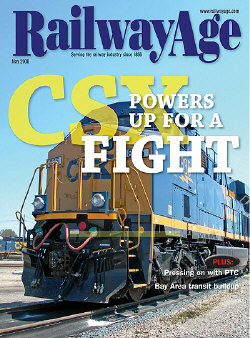 May 2008 issue | |
| Editor | William C. Vantuono |
|---|---|
| Categories | Trade magazine |
| Frequency | Monthly |
| Publisher | Simmons-Boardman Publishing Corporation |
| First issue | 1856 |
| Country | United States |
| Based in | Chicago |
| Language | English |
| Website | www |
| ISSN | 0033-8826 |
| OCLC | 6973348 |
Railway Age is an American trade magazine for the rail transport industry. It was founded in 1856 in Chicago (the United States' major railroad hub) and is published monthly by Simmons-Boardman Publishing Corporation.